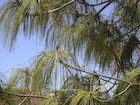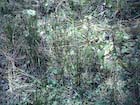
A tree at Monte Alban [C.J. Earle, 2005.02.07].

Same tree, foliar units [C.J. Earle, 2005.02.07].

Same tree, a single fascicle, about 30 cm long [C.J. Earle, 2005.02.07].

Same tree, 90 cm DBH, bark [C.J. Earle, 2005.02.07].

Same tree, cones in situ [C.J. Earle, 2005.02.07].

050208-24 Forest of P. pseudostrobus var. apulcensis and P. lawsoni along Mex-175 N of the city of Oaxaca [C.J. Earle, 2005.02.08].

Seedlings in the "grass" stage [C.J. Earle, 2005.02.08].

Cone collected along Mex-175 N of the city of Oaxaca [C.J. Earle, 2005.02.10].

Detail showing thick, elongated apophysis on the cone shown above [C.J. Earle, 2005.02.10].

Conservation Status

Pinus pseudostrobus var. apulcensis
(Lindley) G.R. Shaw 1909
Common names
Pino. The scientific name, apulcensis, means "from Apulco," the town where it was first collected in 1838 by C.T. Hartweg. Hartweg was busy that year, also collecting the tree that Lindley would name Pinus hartwegii.
Taxonomic notes
Synonymy (Farjon and Styles 1997, Farjon 1998):
- Pinus apulcensis Lindley 1839 (type, Hidalgo: ravines near Apulco, 1838, Hartweg s.n.)
- P. pseudostrobus Lindley var. apulcensis (Lindley) Martínez 1945 non Shaw 1909
- P. pseudostrobus Lindley forma megacarpa Loock 1950
- P. pseudostrobus Lindley subsp. apulcensis (Lindley) Stead 1984, typ. excl.
- P. pseudostrobus Lindley var. oaxacana Martínez 1945, nom. inval., sine lat.
- P. oaxacana Mirov 1958 (type, Oaxaca: "Near La Parada," 1894. Nelson 985)
- P pseudostrobus Lindley var. oaxacana (Mirov) S.G. Harrison 1965
- Pinus oaxacana var. diversiformis Debreczy et Rácz 1995
You will often see the name P. oaxacana, which is a mellifluous name well suited to this graceful tree of Oaxaca. However, the name P. apulcensis unquestionably has priority due to its earlier publication. A reasonable argument could be made in favor of treating this taxon as a species in its own right, for it may not be particularly closely related to the type of P. pseudostrobus, at least in the context of the fine distinctions that are often drawn between Mexican pines at the species rank. It might also be treated at the subspecies rank, a combination that has not been published. It is also possible that P. nubicola J.P. Perry, which Farjon and Styles (1997) list as a synonym of the type variety of P. pseudostrobus, is more accurately placed as a synonym of var. apulcensis.
Description
As for the species, with the following distinctions: Apophysis variable, prominently raised and partly elongated, especially on one side of the cone and toward the base, transversely keeled, rhombic or pentagonal in outline, upper margin angular, irregularly undulate, or rounded, color in various hues of brown. Umbo dorsal, prominent and/or elongated, 5-15 mm long, 5-10 mm wide at base, without a prickle, usually darker than the apophysis (Farjon and Styles 1997). See García Esteban et al. (2004) for a detailed characterization of the wood anatomy.
Distribution and Ecology
Mexico: Chiapas, Guerrero, Hidalgo, Puebla, Tlaxcala, W-C Veracruz, México, Oaxaca, and Veracruz. Also in the Guatemala highlands and N El Salvador. It is most common in Oaxaca, where it is perhaps even more common than var. pseudostrobus. It is often sympatric and occupies much the same habitat but seems absent from the driest locations (Farjon and Styles 1997). Hardy to Zone 9 (cold hardiness limit between -6.6°C and -1.1°C) (Bannister and Neuner 2001).
Remarkable Specimens
Ethnobotany
Observations
As the photographs show, there are splendid specimens at the ruins of Monte Alban above the city of Oaxaca. We also found it widely distributed along Mex-175 starting about 20 km N of the city of Oaxaca and continuing sporadically at least to the town of Ixtlan de Juarez. In this area it forms continuous, closed-canopy forests with a variety of pines, prominently including P. lawsoni and P. montezumae.
In El Salvador, it occurs on Cerro el Pita from 1500 to 2500 m elevation, mixed with Pinus tecunumanii (Fernando Tobar email 2008.11.12).
Remarks
In Oaxaca and Chiapas, this species is a principal host for the dwarf mistletoes Arceuthobium aureum subsp. petersonii and A. nigrum (Hawksworth and Wiens 1996).
Citations
See also









